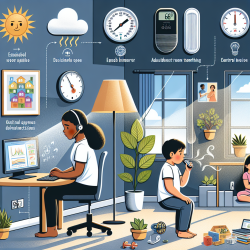Introduction
In the realm of speech-language pathology, understanding the factors that influence a child's learning environment is crucial. Recent advances in the study of indoor environmental quality (IEQ) provide a wealth of data that can help practitioners enhance their skills and improve outcomes for children. This blog delves into the findings of the research article "Current State of the Science: Health Effects and Indoor Environmental Quality" and explores how these insights can be applied in practice.
The Interplay Between Indoor Environment and Health
The research highlights the complex interactions between indoor environments and occupant health, emphasizing that the built environment is more than just a backdrop for human activity. It is a dynamic entity that influences health outcomes through various physical, chemical, and biological factors. For practitioners working with children, this underscores the importance of considering environmental factors as part of a holistic approach to therapy.
Key Findings and Implications for Practice
- Source Characterization: Understanding how pollutants are transported and transformed indoors is essential. Practitioners can use this knowledge to advocate for better ventilation and air quality in schools and therapy settings.
- Exposure Assessment: Accurate assessment of exposure to pollutants is challenging but necessary. By staying informed about the latest methods, practitioners can better identify potential environmental risks and mitigate them.
- Health Effects: The research highlights the impact of indoor pollutants on vulnerable populations, including children. Practitioners should be aware of these risks and incorporate environmental assessments into their practice.
- Building Design and Health: The design and operation of buildings can significantly affect occupant health. Practitioners can collaborate with school administrators and architects to create healthier learning environments.
Encouraging Further Research
While the research provides valuable insights, it also highlights areas where further study is needed. Practitioners are encouraged to stay engaged with ongoing research and contribute to the development of evidence-based practices. By doing so, they can ensure that their interventions are grounded in the latest scientific understanding.
Conclusion
The evolving understanding of indoor environmental quality offers exciting opportunities for practitioners to enhance their skills and improve outcomes for children. By integrating these insights into practice, speech-language pathologists can create healthier, more supportive environments for their young clients.
To read the original research paper, please follow this link: Current State of the Science: Health Effects and Indoor Environmental Quality.










